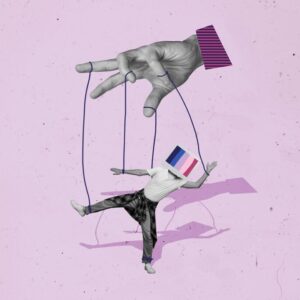
On September 25, the administration of President Donald Trump issued National Security Presidential Memorandum-7 (NSPM-7).
The alleged purpose is for federal agencies to “counter domestic terrorism and organized political violence.” But legal experts and nonprofit leaders believe that it serves as a blueprint for the federal government to classify advocacy, protesting, and civic organizing as public dangers meriting state repression.
More than 3,000 nonprofits have signed an open letter condemning the directive, assailing the administration memo as a violation of free speech and civic engagement. However, it’s clear that strongly worded letters can only achieve so much.
NPQ spoke with experts about how, beyond writing letters of protest, nonprofits and the public can effectively respond.
A Legal Blueprint for Intimidation
Experts describe the memo as a strategic expansion of existing powers that relies on fear and complying in advance, rather than actual enforcement.
“The immediate legal risk of NSPM-7 is the weaponization of existing federal agencies to achieve political goals, specifically targeting progressive, antiracist, and social justice organizations,” Janga Bussaja, founder of Planetary Chess, a nonprofit that seeks to eradicate racism, told NPQ.
“The greatest danger is that organizations, fearing audits and the revocation of tax-exempt status by the IRS or criminal investigations…will preemptively self-censor their activities around race, gender, and social justice,” said Bussaja. “This is the primary goal of the memo: to suppress dissent without filing a single charge.”
He warned that the real danger is self-censorship: “By complying in advance, organizations surrender their mission before the fight even begins.”
“NSPM-7 functions less as policy than as a political instrument that uses uncertainty and fear to achieve compliance.”
Jonathan Miller, chief program officer for Public Rights Project, a nonprofit signatory of the open letter that uses litigation to protect civil rights, told NPQ that the memo does not create new legal authority, but rather rebrands existing powers in a way that politicizes enforcement.
“The administration can’t lawfully punish organizations for their viewpoints or advocacy,” Miller said. “The main goal of these efforts is that intimidation will discourage them from exercising their rights.”
Legal scholars outside the nonprofit sector share those concerns. In an interview with Newsweek, Lee Rowland, executive director of the National Coalition Against Censorship, warned that the directive’s phrasing could chill constitutionally protected expression.
“Radical ideas designed to change policy outcomes are also known as political speech at the very core of the First Amendment. Period, full stop,” she said.
Together, these assessments suggest NSPM-7 functions less as policy than as a political instrument that uses uncertainty and fear to achieve compliance.
Prepare, Coordinate, and Act Together
As NSPM-7 forces nonprofits to weigh legal risk against mission, experts speaking with NPQ advised nonprofits when responding to prepare, coordinate, and—most importantly—act together in solidarity.
Beth Southorn, executive director of LifeSTEPS, a California antipoverty nonprofit, told NPQ that readiness begins with infrastructure.
“Create bridge funding mechanisms between organizations serving the same populations,” she said.
Southorn’s nonprofit, which operates a federally funded Family Self-Sufficiency program, has “built relationships with 15 partner agencies who could immediately absorb clients if our funding got disrupted.” LifeSTEPS has formalized those partnerships through written agreements that ensure service continuity within 72 hours of a disruption.
“Pool resources. Combine legal, communications, and operational capacity to respond efficiently to threats that no single organization could manage alone.”
She also advised nonprofits to treat their reserves as a form of insurance. For example, after LifeSTEPS got a $125,000 bank foundation grant, “We immediately allocated 30 percent to an untouchable emergency reserve that covers six months of core staff salaries.” She calls this “disruption insurance.”
Miller told NPQ that solidarity and coordination are the sector’s best defenses: “Nonprofits are facing an unprecedented moment of scrutiny and intimidation. To withstand these attacks and continue serving their communities, organizations must move beyond statements of concern and act together to protect their independence and shared mission.”
He pointed to coalition work and resource sharing as the most effective response: “Join coordinated advocacy efforts. Work in coalition with peer organizations to demonstrate collective strength. Share information and legal guidance. Pool resources. Combine legal, communications, and operational capacity to respond efficiently to threats that no single organization could manage alone.”
Nonprofits must move beyond defensive posturing to…strategies focused on disrupting the financial and power structures that sustain inequity.
An End to Nonprofit Innocence?
For Bussaja, the call to act also means confronting the deeper systems that make this kind of political targeting possible.
“The collective outcry against NSPM-7—a clear act of political targeting—is hypocritical given the sector’s history of dodging the systemic issue at hand,” Bussaja told NPQ. He argued that nonprofits must move beyond defensive posturing to proactive, research-backed strategies focused on disrupting the financial and power structures that sustain inequity.
“Solidarity funds and legal alliances only prolong the inevitable conflict within a rigged system,” he said.
Bussaja contends that an effective long-term nonprofit response must act to change the systems that make nonprofits vulnerable, redirecting resources away from institutions that reinforce inequity, and building community-controlled funding and governance models that can’t be easily undermined by political pressure.
In short, Bussaja argues that protecting nonprofit autonomy requires changing where and how money flows and who holds power.
Building Power for the Long Term
Experts told NPQ that public solidarity and long-term investment in the sector are critical to help nonprofits build power and withstand federal intimidation efforts.
“Local governments and nonprofits can be powerful defenders of democracy through collective action,” said Miller. “In moments like this, when federal rhetoric threatens to chill advocacy and silence dissent, solidarity becomes both a legal and moral imperative. What’s at stake isn’t just nonprofit independence, but the freedom to stand up for justice itself.”
That solidarity must be matched by practical support, noted Southorn.
“For public support, ask donors to fund your operational reserves specifically,” she told NPQ. “That’s the difference between surviving a disruption and closing your doors.”
Miller said public support must move beyond mere words of solidarity. It’s time to put money behind the principles that nonprofits defend. “Individuals, foundations, and companies can support nonprofits by funding nonprofits that protect people’s rights and hold government power in check through advocacy and litigation.”
“They also can publicly affirm that civic engagement…is a core American value, not a crime,” said Miller.
Ultimately, nonprofits must build power for the long term. For Bussaja, this requires that nonprofits not shy away from confronting economic and racial inequality directly: “The public and philanthropic community must invest in the organizations bold enough to confront the root cause, not just those managing the consequences.”













